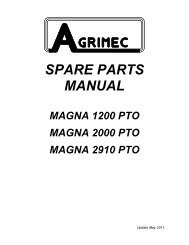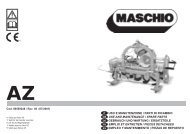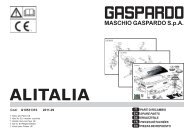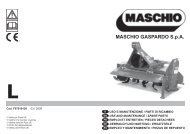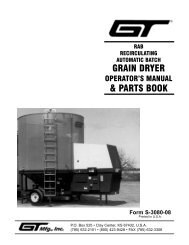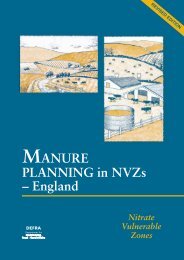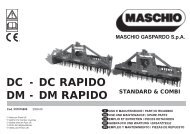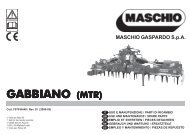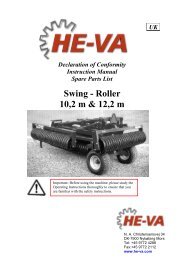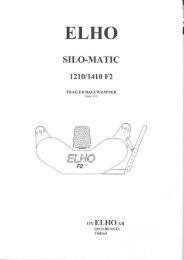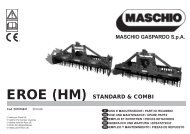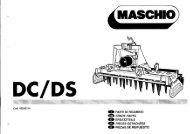GIRAFFETTA OK15.pmd - Opico
GIRAFFETTA OK15.pmd - Opico
GIRAFFETTA OK15.pmd - Opico
Create successful ePaper yourself
Turn your PDF publications into a flip-book with our unique Google optimized e-Paper software.
ITALIANO ENGLISH FRANÇAIS DEUTSCH<br />
ESPAÑOL<br />
- In fase di lavoro il cofano posteriore<br />
deve rimanere chiuso.<br />
Sollevarlosolamente in caso di interventi<br />
dimanutenzione sulla macchina,<br />
amotore spento e trattore bloccato.<br />
3.18 COME SI LAVORA<br />
Utilizzo in campo<br />
Dopo avere agganciato correttamente la macchina<br />
al trattore procedere come segue:<br />
- Agendo sui comandi del sollevatore, abbassare<br />
la macchina fino a che il rullo posteriore<br />
appoggi a terra e che gli utensili arrivino<br />
in prossimità del terreno senza toccarlo.<br />
- Innestare la P.T.O. ed accelerare gradualmente<br />
il trattore fino a raggiungere la velocità<br />
della P.T.O. (540 giri/min.).<br />
È assolutamente sconsigliabile superare<br />
i giri sopra indicati in quanto la macchina<br />
è stata dimensionata per funzionare<br />
a quelle velocità avendo in tal modo<br />
il massimo rendimento della stessa.<br />
- Innestare la marcia a cominciare la lavorazione.<br />
- Se necessario regolare con il sollevatore l'altezza<br />
di lavoro, evitando che gli organi di<br />
taglio (coltelli o mazza) vadano a contatto<br />
con il terreno (Fig. 38).<br />
- Se necessario regolare la velocità del trattore.<br />
- Regolando la posizione del rullo si aumenta<br />
o si diminuisce l'altezza di taglio rispetto<br />
al terreno (altezza min. 3 cm, Fig. 38).<br />
- During work the rear bonnet must<br />
remain closed. Open it only in case<br />
of maintenance on the<br />
machine,when the engine is off and<br />
the tractor braked.<br />
3.18 HOW TO WORK<br />
Use in the field<br />
Hitch the machine to the tractor correctly<br />
and proceed in the following way;<br />
- Using the power lift controls, lower the<br />
machine until the rear roller rests on<br />
the ground and the tools are near to<br />
the ground without touching it.<br />
- Engage the PTO and gradually accelerate<br />
the tractor engine until the PTO<br />
is spinning at the required speed (540).<br />
It is highly inadvisable to exceed<br />
this rate as the machine has been<br />
sized to provide its utmost efficiency<br />
at these speeds.<br />
- Engage the gear and begin to work.<br />
- Adjust the work height with the power<br />
lift controls if necessary.<br />
Remember that the cutting tools<br />
(knives or hammers) must not touch<br />
the ground (Fig. 38).<br />
- Modify the speed of the tractor if necessary.<br />
- Adjust the position of the roller to raise<br />
or lower the cutting height from the<br />
ground (min. height 3 cm, Fig. 38).<br />
Min. 3 cm<br />
- Pendant le travail le capot arrière<br />
doit rester fermée. Ouvrir seulement<br />
dans le cas de entretien de la<br />
machine,avec le moteur éteint et le<br />
tracteur bloqué.<br />
3.18 COMMENT<br />
TRAVAILLER AVEC<br />
LA MACHINE<br />
Utilisation sur champ<br />
Après avoir attelé correctement la machine au<br />
tracteur, procéder de la manière suivante;<br />
- En agissant sur les commande du relevage,<br />
abaisser la machine jusqu’à ce que le<br />
rouleau arrière appuie sur le sol et que les<br />
outils arrivent à proximité du sol sans le<br />
toucher.<br />
- Embrayer la P.D.F. et accélérer graduellement<br />
le tracteur jusqu’à ce que la P.D.F.<br />
atteigne la vitesse de (540 tours/mn).<br />
Il est absolument déconseillé de<br />
dépasser les tours indiqués ci-dessus<br />
car la machine a été dimensionnée pour<br />
fonctionner à ces vitesses et obtenir le<br />
meilleur rendement possible de celle-ci.<br />
- Passer la vitesse et commencer à travailler.<br />
- Si nécessaire régler la hauteur de travail<br />
avec le relevage, en évitant de mettre les<br />
organes de coupe (couteaux ou marteaux)<br />
en contact avec le sol (Fig.38).<br />
- Si nécessaire régler la vitesse du tracteur.<br />
- Le réglage de la position du rouleau permet<br />
d’augmenter ou de diminuer la hauteur de<br />
coupe par rapport au sol (hauteur min. 3<br />
cm, Fig. 38).<br />
OK<br />
- Während der Arbeit der hintere<br />
Haubemüß geschlossen<br />
bleiben.Öffnen nur im Falle von<br />
Wartungsarbeiten<br />
an<br />
derMaschine,bei abgestelltem<br />
Motorund bei blockiertem<br />
Schlepper.<br />
3.18 WIE MAN MIT DER<br />
MASCHINE ARBEITET<br />
Verwendung auf dem Feld<br />
Nachdem man die Maschine richtig am<br />
Schlepper angehängt hat, wie folgt vorgehen:<br />
- Anhand der Bedienungen des Krafthebers<br />
die Maschine so weit absenken,<br />
bis die hintere Walze am Boden aufliegt<br />
und sich die Werkzeuge in Nähe<br />
des Bodens befinden, ohne ihn zu berühren.<br />
- Die Zapfwelle einkuppeln und den<br />
Schlepper stufenweise beschleunigen,<br />
bis die Zapfwelle 540 Umdrehungen/<br />
Min. erreicht.<br />
Keinesfalls die o. g. Umdrehungen<br />
überschreiten, weil die Maschine<br />
zum Betrieb mit diesen Geschwindigkeiten<br />
dimensioniert ist und auf<br />
diese Weise die maximale Leistung<br />
erbringt.<br />
- Den Gang einkuppeln und mit der Bearbeitung<br />
beginnen.<br />
- Gegebenenfalls mit dem Kraftheber die<br />
Arbeitshöhe regeln und dabei vermeiden,<br />
daß die Schneidorgane (Messer<br />
oder Schlegel) den Boden berühren<br />
(Abb. 38).<br />
- Gegebenenfalls die Schleppergeschwindigkeit<br />
regeln.<br />
- Durch die Verstellung der Walzenposition<br />
wird die Schnitthöhe vom Boden<br />
erhöht oder verringert (Mindesthöhe<br />
3 cm, Fig. 38).<br />
-Durante el trabajo el cofre trasero<br />
debe permanecer cerrado.<br />
Levantarlo sólo en el caso<br />
demantenimiento en la máquina,<br />
contractor bloqueado y motor<br />
apagado.<br />
3.18 CÓMO SE TRABAJA<br />
Utilización en el campo<br />
Después de haber enganchado correctamente<br />
la máquina en el tractor operar<br />
del siguiente modo:<br />
- Con los mandos del elevador, bajar la<br />
máquina hasta que el rodillo trasero se<br />
apoye sobre el terreno y los equipos<br />
se posicionen cerca del terreno sin tocarlo.<br />
- Conectar la TDF y acelerar gradualmente<br />
el tractor hasta alcanzar la velocidad<br />
de la TDF (540 rpm).<br />
No superar nunca las revoluciones<br />
máximas ya que la máquina ha sido<br />
dimensionada para funcionar a las<br />
velocidades prescriptas, ofreciendo<br />
a las mismas el máximo rendimiento.<br />
- Conectar la marcha y comenzar el trabajo.<br />
- Si es necesario regular con el elevador<br />
la altura de trabajo, evitando que<br />
los componentes de corte (cuchillas o<br />
martillo) toquen el terreno (Fig. 38).<br />
- Si es necesario regular la velocidad del<br />
tractor.<br />
- Regulando la posición del rodillo se<br />
aumenta o se disminuye la altura de<br />
corte respecto al terreno (altura min. 3<br />
cm, Fig. 38).<br />
Fig. 38<br />
39



